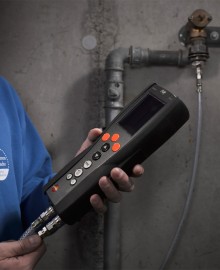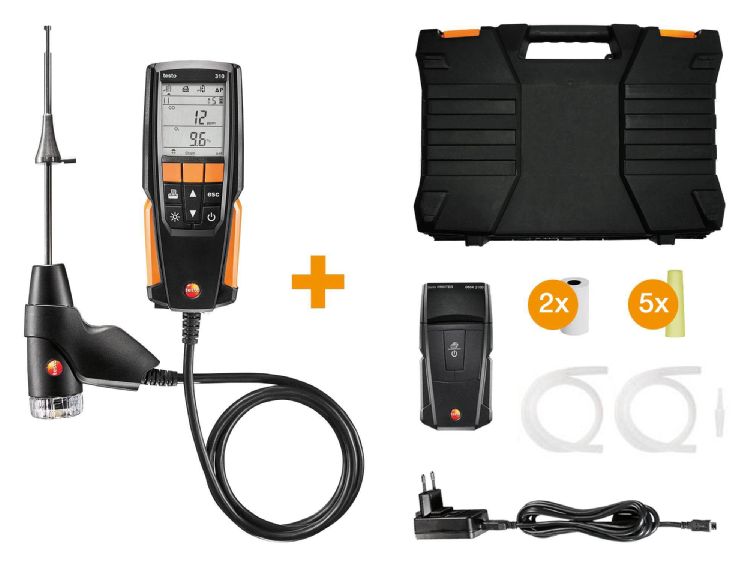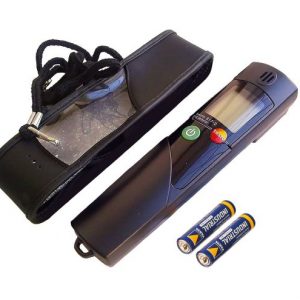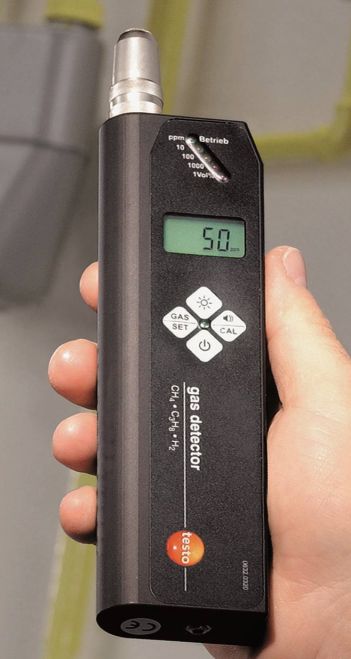Description
The testo 310 has two measurement cells for O2 and CO, and a temperature sensor integrated into the flue gas probe. The gas sensors measure the exact oxygen and carbon monoxide content as well as the flue gas and ambient temperature. From these data, all relevant measurement parameters such as CO2 value, degree of effectivity and flue gas loss are calculated. The instrument stands out thanks to its easy handling and menu-guided security. You can read off the measurement values confidently and conveniently from the well-lit display, even in bad light conditions. The fuels are stored not just as numbers, but are each described. At the top edge of the clear display, the symbols for the different measurement menus are always in view. The display and the dirt-insensitive keypad are clearly structured. Operation is very easy – even if you only have one hand free. Applications: • Flue gas measurement • Draught measurement • Ambient CO measurement • Pressure measurement
Testo 310, Testo 310 flue gas analyser, Testo 310 combustion analyser, Testo 310 with printer, testo 310 combustion analyser kit, combustion analyser with printer, testo 0563 3100, residential combustion analyser, testo 310 price, testo flue analyser, 0563 3100, 0563 3110, 310 testo, testo 310 analyser, test o310 flue gas analyser, testo 310 combustion analyser kit with printer, testo 310 flue gas analyser printer kit
Additional information
| Weight | 2 kg |
|---|
Application
Applications
Draught measurement in the flue gas duct
Draught measurement is actually a differential pressure measurement. This differential pressure occurs between two sub-areas as a result of a difference in temperature. This is turn generates a flow to compensate. In the case of flue gas systems, the difference in pressure is an indicator of the “chimney flue draught”. This is measured between the flue gas and ambient air at the measurement orifice at the core of the flue gas flow.
To ensure the flue gases are safely transported through the chimney there must be a differential pressure (chimney flue draught) for boiler systems that work with low pressure.
If the draught is permanently too high, the average flue gas temperature increases and therefore flue gas loss. The level of efficiency drops.
If the draught is permanently too low, oxygen may be lacking during combustion, resulting in soot and carbon monoxide. This will also cause a drop in the level of efficiency.
Ambient CO measurement in the heated environment
Carbon monoxide (CO) is a colourless, odourless and taste-free gas, but also poisonous. It is produced during the incomplete combustion of substances containing carbon (oil, gas, and solid fuels, etc.). If CO manages to get into the bloodstream through the lungs, it combines with haemoglobin thus preventing oxygen from being transported in the blood; this in turn will result in death through suffocation. This is why it is necessary to regularly check CO emissions at the combustion points of heating systems, and places often frequented by people (in our case, where the combustion systems for hot water generation are), and in the surrounding areas.
Measuring the flue gas parameters of the burner (CO, O2, and temperature, etc.)
The flue gas measurement for a heating system helps to establish the pollutants released with the flue gas (e.g. carbon monoxide CO) and the heating energy lost with the warm flue gas. In some countries, flue gas measurement is a legal requirement. It primarily has two objectives:
1. Ensuring the atmosphere is contaminated as little as possible by pollutants; and
2. energy is used as efficiently as possible.
Stipulated pollutant quantities per flue gas volume and energy losses must never be exceeded.
Measurement in terms of results required by law takes place during standard operation (every performance primarily using the appliance). Using a Lambda probe (single hole or multi-hole probe), the measurement is taken at the centre of flow in the connecting pipe (in the centre of the pipe cross-section, not at the edge) between the boiler and chimney/flue. The measured values are recorded by the flue gas analyzer and can be logged either for print out or transfer to a PC at a later stage.
Measurement is taken by the installer at commissioning, and if necessary four weeks later by the flue gas inspector/chimney sweep, and then at regular intervals by the authorised service engineer.
Measuring pressure on burners (nozzle pressure, gas flow pressure, etc.)
Standard readings taken during services of domestic heating systems include checking the gas pressure on the burners. This involves measuring the gas flow pressure and gas resting pressure. The flow pressure, also called supplied pressure, refers to the gas pressure of the flowing gas and resting pressure of the static gas. If the flow pressure for gas boilers is slightly outside the 18 to 25 mbar range, adjustments must not be made and the boiler must not be put into operation. If put into operation nonetheless, the burner will not be able to function properly, and explosions will occur when setting the flame and ultimately malfunctions; the burner will therefore fail and the heating system will shut down.
Downloads
Downloads
User Manual
https://static-int.testo.com/media/44/09/24c5948e0507/testo-310-Instruction-Manual.pdf






Reviews
There are no reviews yet.